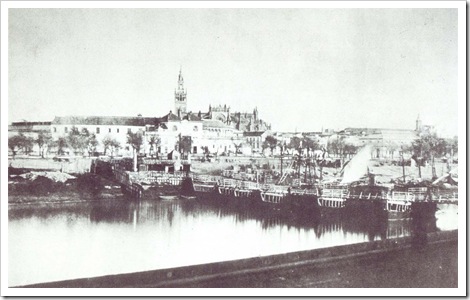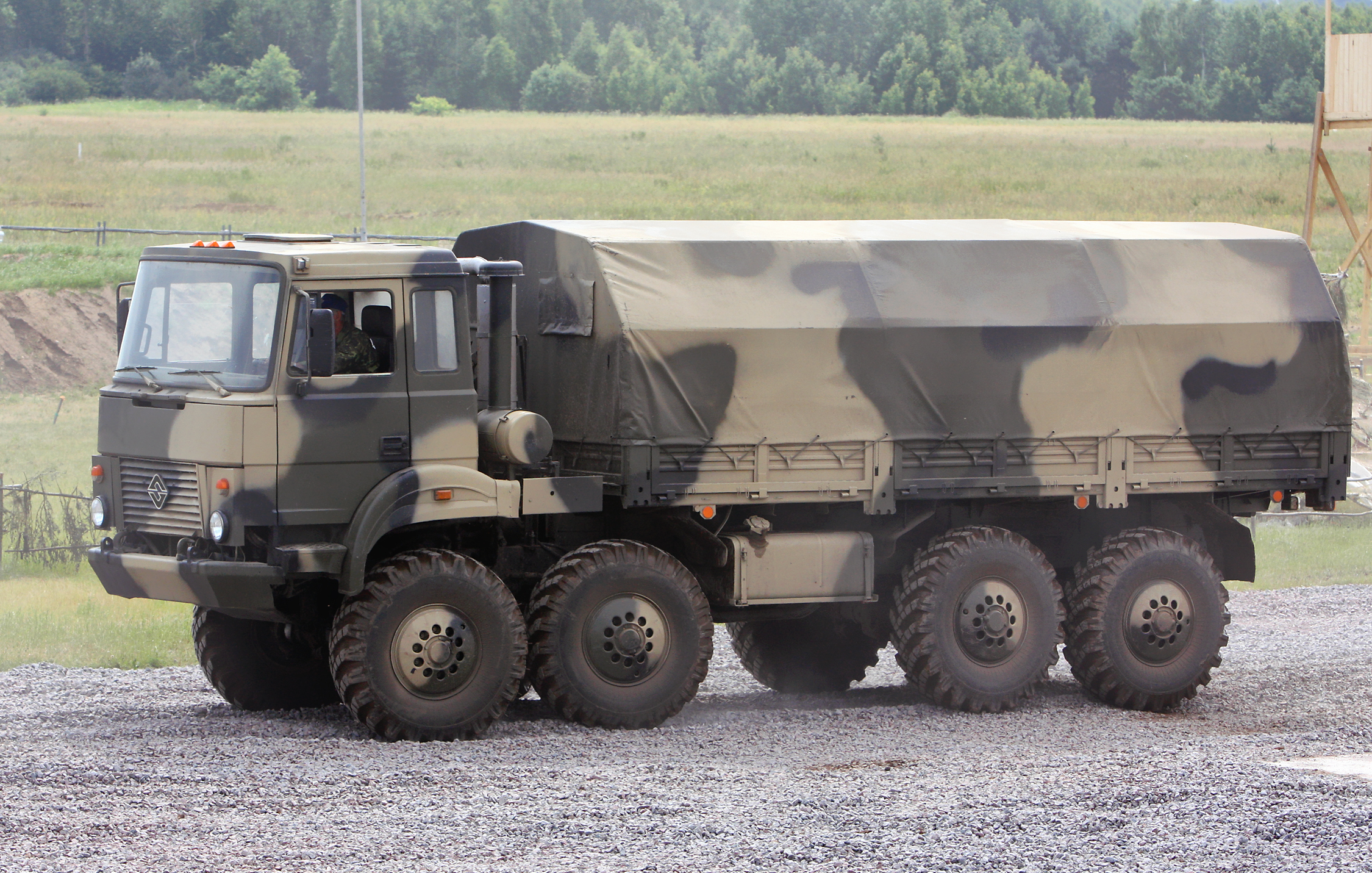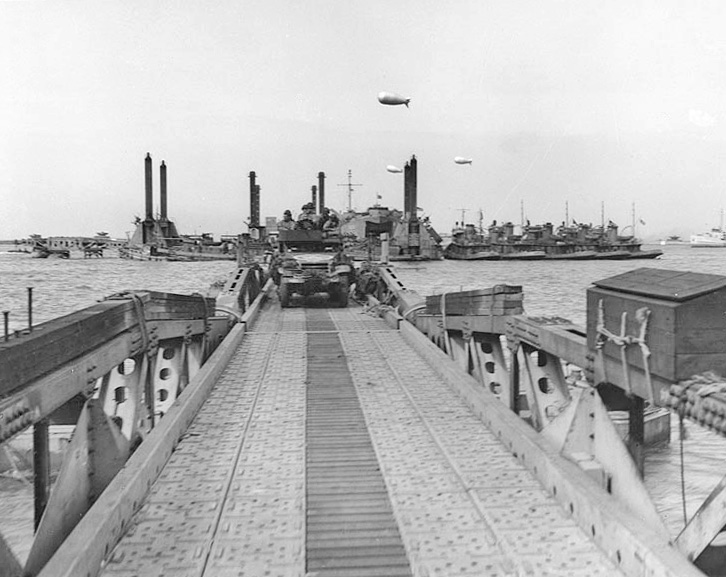|
PMP Floating Bridge
The PMP Floating Bridge ( "pontoon / bridge park") is a type of mobile pontoon bridge designed by the Soviet Union after World War II. The bridge's design enables for a quick assembly of its parts. It has a carrying capacity of 60 tons. The bridge was originally mounted on a KrAZ-214 The KrAZ-214 is an off-road truck 6x6 for extreme operations.Н. Чистов. Модернизированный КрАЗ // "За рулём", № 10, октябрь 1961. стр.14 It was manufactured in the Soviet Union at the Yaroslavl Motor ..., but later transferred to a KrAZ-255. During the process of its deployment, a truck carrying the bridge is backed alongside the edge of a body of water. The bridge is then rolled off where it unfolds automatically. The bridge spans 382 metres, load capacity 20 tons, or 227 m, load capacity 60 tons, with 32 river pontoons, 12 bridging boats and four shore pontoons. The PMP was superseded by the PPS-84 and later the PP-91 bridge system after the breakup ... [...More Info...] [...Related Items...] OR: [Wikipedia] [Google] [Baidu] |
PM M71
PM or pm (also written P.M. or p.m.) is an abbreviation for Latin ''post meridiem'', meaning "after midday" in the 12-hour clock. PM or Pm or pm may also refer to: Arts and entertainment *Palm mute, a guitar playing technique * ''PM'' (radio program), Australia * ''PM'' (BBC Radio 4), UK *''PM Magazine'', an American TV news program (1976–1991). * ''PM'' (newspaper), US (1940–1948) *PM Press, an American publishing company *''Pocket Mortys'', a role-playing video game * Project Mayhem, a fictional conspiracy in the book and film ''Fight Club'' * PM, a band with drummer Carl Palmer. Business and economics Businesses * P.M. Place Stores, a former US chain of discount stores *Pere Marquette Railway, North America 1900–1947, reporting mark *Philip Morris International, a tobacco company Terminology *Performance management of an organisation *Portfolio manager *Preventive maintenance *Project manager *Product manager *Program manager * Product marketer Government *Prime minis ... [...More Info...] [...Related Items...] OR: [Wikipedia] [Google] [Baidu] |
Pontoon Bridge
A pontoon bridge (or ponton bridge), also known as a floating bridge, is a bridge that uses float (nautical), floats or shallow-draft (hull), draft boats to support a continuous deck for pedestrian and vehicle travel. The buoyancy of the supports limits the maximum load that they can carry. Most pontoon bridges are temporary and used in wartime and civil emergencies. There are permanent pontoon bridges in civilian use that can carry highway traffic; generally, the relatively high potential for collapse and sinking (e.g. due to waves and collisions) and high continuous maintenance costs makes pontoons unattractive for most civilian construction. Permanent floating bridges are useful for sheltered water crossings if it is not considered economically feasible to suspend a bridge from anchored Pier (architecture), piers (such as in deep water). Such bridges can require a section that is elevated or can be raised or removed to allow waterborne traffic to pass. Notable permanent pontoo ... [...More Info...] [...Related Items...] OR: [Wikipedia] [Google] [Baidu] |
Soviet Union
The Union of Soviet Socialist Republics. (USSR), commonly known as the Soviet Union, was a List of former transcontinental countries#Since 1700, transcontinental country that spanned much of Eurasia from 1922 until Dissolution of the Soviet Union, it dissolved in 1991. During its existence, it was the list of countries and dependencies by area, largest country by area, extending across Time in Russia, eleven time zones and sharing Geography of the Soviet Union#Borders and neighbors, borders with twelve countries, and the List of countries and dependencies by population, third-most populous country. An overall successor to the Russian Empire, it was nominally organized as a federal union of Republics of the Soviet Union, national republics, the largest and most populous of which was the Russian SFSR. In practice, Government of the Soviet Union, its government and Economy of the Soviet Union, economy were Soviet-type economic planning, highly centralized. As a one-party state go ... [...More Info...] [...Related Items...] OR: [Wikipedia] [Google] [Baidu] |
World War II
World War II or the Second World War (1 September 1939 – 2 September 1945) was a World war, global conflict between two coalitions: the Allies of World War II, Allies and the Axis powers. World War II by country, Nearly all of the world's countries participated, with many nations mobilising all resources in pursuit of total war. Tanks in World War II, Tanks and Air warfare of World War II, aircraft played major roles, enabling the strategic bombing of cities and delivery of the Atomic bombings of Hiroshima and Nagasaki, first and only nuclear weapons ever used in war. World War II is the List of wars by death toll, deadliest conflict in history, causing World War II casualties, the death of 70 to 85 million people, more than half of whom were civilians. Millions died in genocides, including the Holocaust, and by massacres, starvation, and disease. After the Allied victory, Allied-occupied Germany, Germany, Allied-occupied Austria, Austria, Occupation of Japan, Japan, a ... [...More Info...] [...Related Items...] OR: [Wikipedia] [Google] [Baidu] |
KrAZ-214
The KrAZ-214 is an off-road truck 6x6 for extreme operations.Н. Чистов. Модернизированный КрАЗ // "За рулём", № 10, октябрь 1961. стр.14 It was manufactured in the Soviet Union at the Yaroslavl Motor Plant, YaMZ plant from 1956-1959, after which production was moved to KrAZ. The model line was the successor to the YaG-10 trucks. Technical characteristics *Engine: 6.97 L diesel 6 cyl. *Power: 205 PS /2000rpm *Torque: 765 Nm /1300rpm *Top speed: 55 mph Variants * KrAZ-214 (''КрАЗ-214''): cargo truck. Produced 1959-1963. * KrAZ-214B (''КрАЗ-214Б''): Updated version of KrAZ-214 with improved suspension and a 24-volt electrical system. Produced 1963-1967. * E-305V (''Э-305В'') - military excavator on KrAZ-214 chassis Operators Current operators * - One truck lost at the beginning of the Russian invasion of Ukraine, 2022 Russian invasion of Ukraine. Former operators * - Soviet Armed Forces References {{KrA ... [...More Info...] [...Related Items...] OR: [Wikipedia] [Google] [Baidu] |
KrAZ-255
The KrAZ-255 is a Soviet three-axle off-road truck with six-wheel drive (6 × 6), intended for extreme operations. It was manufactured at the KrAZ plant beginning from 1967. The KrAZ-255 was developed directly from its predecessor, the KrAZ-214 (produced 1956-1967). Despite being very similar at first glance (both using the same cab, flatbed as well as the suspension), there are few major differences. Firstly, the 255 used new and much more powerful engine - the YaMZ-238 (same used in MT-LB tracked APC), replacing the previously used and sensibly weaker YaAZ-206B which was used in 214. The 255 also featured new and more reliable transmission, the YaMZ-236N, instead of the previously used YaAZ-204. It also featured new headlights (which were now, together with turn signals, located in their own housings mounted on the fenders) and, most notably, much wider tires (1300 x 530 x 533 in dimensions), which offered lighter ground pressure and thus, even greater off-road capabilitie ... [...More Info...] [...Related Items...] OR: [Wikipedia] [Google] [Baidu] |
Ural-5323
The Ural-5323 is an 8×8 heavy-duty off-road truck specially designed for army service. It has been produced since 1989 by the Ural Automotive Plant located in Miass, Russia. The Ural-5323 is a platform for the Pantsir-S1 gun-missile Air Defense System. The Ural-5323-20, with its 8x8 wheel configuration, is designed to carry cargo weighing up to 10 tons and tow trailers with a full weight up to 16 tons. The military version differs from the civilian version as its headlights are located on the cab. Civilian versions are sold with headlights located in the bumper. Earlier versions were equipped with cabs from Kamaz, which complicated production and were less suitable than the replacement Iveco cabs which were provided after 2000. Specifications *Units hermetization system *Remote tire pressure control. *Payload: . *Drive: 8×8. *Suspension: dependent, solid axles with leaf springs, rear - solid axles on balance-cart. rear - solid axles on balance-cart. *Engine: YaMZ-238 ... [...More Info...] [...Related Items...] OR: [Wikipedia] [Google] [Baidu] |
PP-64 Wstęga
The PP-64 Wstęga is a Polish military pontoon bridge produced since 1966.Jane's Military Vehicles and Logistics, April 28, 2009 The design, based on the Soviet PMP model, commenced in 1964. The prototype was tested in 1965. Unlike PMP, rated for 60,000 kilogram load, PP-64 was rated for 40,000 kilograms, still sufficient to carry T-54/55 and T-62 main battle tanks of its period. '' Jane's Military Vehicles and Logistics'' staff supposed that PP-64 may also be capable of supporting T-64 and T-72 tanks. PP-64 set consists of 48 truck-mounted pontoons, 12 ramps, six motor boats (carried on twin-axle truck trailers) and other equipment. KH-200 bridging boats used with PP-64 were actually put in production later, in 1971; each is capable of carrying 15 troops.Jane's Military Vehicles and Logistics, May 5, 2009 The human complement in the field reaches 126 soldiers (including 60 Star 660 or Star 266 truck drivers) and 10 NCOs. Depending on the river flow and desired configuration, ... [...More Info...] [...Related Items...] OR: [Wikipedia] [Google] [Baidu] |
PM M71 Floating Bridge
The PM M71 is a Socialist Federal Republic of Yugoslavia (SFRJ) licence-built pontoon bridge of the Soviet PMP Floating Bridge designed after the WWII. The PM M71 deployment process is the same as for Soviet PMP and was primary designed and used by Yugoslav People's Army. Development of the PM M71 began at the end of the 1960s in the MTRZ Sava Kovačević plant in Tivat, with the designation "Project 382". Production began in 1971 and deliveries were made to the Yugoslav People's Army throughout the 1970s and 1980s. Similar to the Soviet PMP, the PM M71 initially used Yugoslav-made FAP 2220 BDS/A trucks for transporting and FAP 1314 S/AV for towing and removing the RPP M68 tugboat. During the 1980s, the set was modernized with newer FAP 2026 BDS/A and FAP 2026 BS/AVG trucks. The PM M71 bridging set includes: *32 floating sections (pontoons), *4 abutment sections, *2 road covers, *12 RPP M68 tugboats, *38 FAP 2026 BDS/A trucks for transportation of the sections, *12 FAP 2026 BDS/A ... [...More Info...] [...Related Items...] OR: [Wikipedia] [Google] [Baidu] |
Pontoon Bridges
A pontoon bridge (or ponton bridge), also known as a floating bridge, is a bridge that uses float (nautical), floats or shallow-draft (hull), draft boats to support a continuous deck for pedestrian and vehicle travel. The buoyancy of the supports limits the maximum load that they can carry. Most pontoon bridges are temporary and used in wartime and civil emergencies. There are permanent pontoon bridges in civilian use that can carry highway traffic; generally, the relatively high potential for collapse and sinking (e.g. due to waves and collisions) and high continuous maintenance costs makes pontoons unattractive for most civilian construction. Permanent floating bridges are useful for sheltered water crossings if it is not considered economically feasible to suspend a bridge from anchored Pier (architecture), piers (such as in deep water). Such bridges can require a section that is elevated or can be raised or removed to allow waterborne traffic to pass. Notable permanent pontoo ... [...More Info...] [...Related Items...] OR: [Wikipedia] [Google] [Baidu] |





